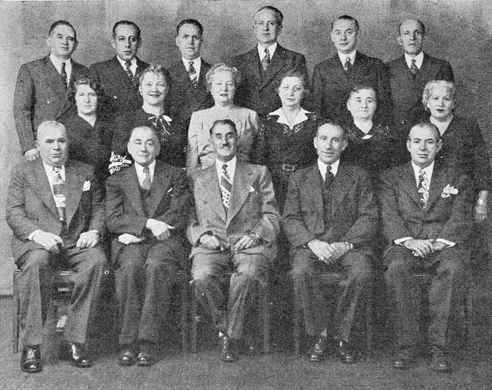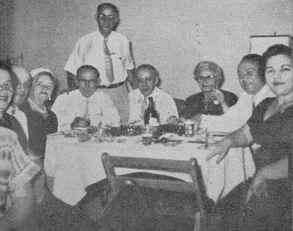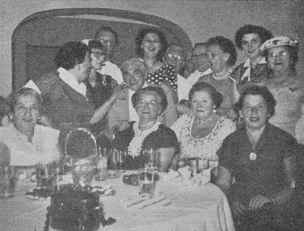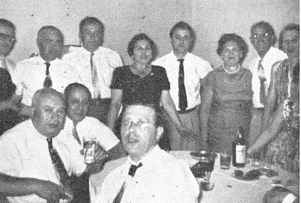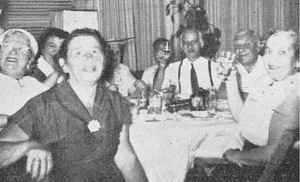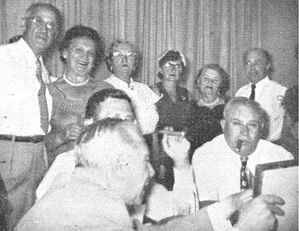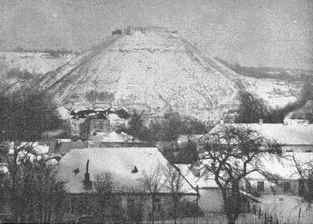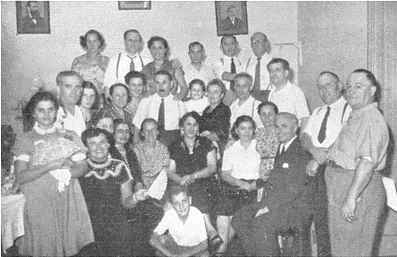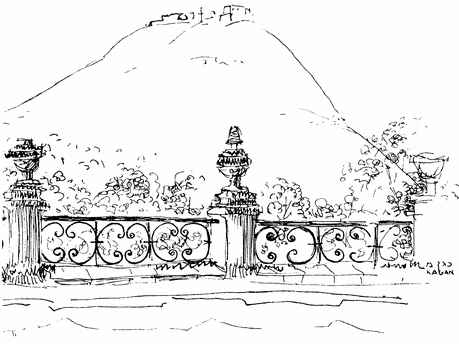[Page 441]
Kremenets in the World
40 Years of the Kremenets Landsmanschaft in New York
by Yitschak Vakman (New York)
(Memories conveyed by Binyamin Barshap)
English Translation by Yocheved Klausner
The emigration from Kremenets to America began some 50-60 years ago. Among the first Kremenetsers who came to America were Yakov Kremenetski, Itshi Foks' three sons, Mendel Heker's son, the Benderski children, and others. At that time, the situation in America was difficult and challenging. The landsleit felt very lonely; therefore, they tried to stick together. Most of them lived in rented single rooms-very few had their own apartments. The landsleit meetings, where they discussed the possibilities of helping the new arrivals, would take place on the flat roof of one of the houses. Help was always given willingly.
In 1900, the first Kremenets social organization in America was created, with the help of Mordekhay Shniter's son. However, due to internal disagreements, the organization was soon dissolved.
In 1904, another organization was founded under the name Independent Order of Beit Avraham. Every member was insured for $500 and obtained a life insurance policy. The money was paid to the family at death and was also used to pay burial expenses. Many members between the ages of 50 and 60 registered, and since a number of them died in a short time, the organization was forced to cut the policy to $250. However, this did not help financially, and this second organization was suspended as well.
Several years later, the Benderski children helped establish an organization called the Yosef Shalom Society-Yosef Shalom was apparently a member of the Benderski family. This society is active to this day but has very few members.
In 1914, at the outbreak of World War I, the Kremenets landsleit received bitter news about the material situation in their old home. The urgent need to send regular help arose.
[Page 442]
|
|
Executive Committee of the Kremenets Landsmanschaft in New York
First row, sitting (right to left): Harry Vayner, Binyamin Barshap, Yitschak Vakman, Henekh Kesler, Isidor Salmovitsh.
Second row, standing: Mrs. F. Vayner, Mrs. D. Goldman, Mrs. G. Berenson, Mrs. Guterman, Mrs. Sander, Mrs. Chaye Rapoport.
Third row, standing: Louis Sigal, L. Berenson, A. Hertsberg, Gordon, Landisberg, Mints. |
|
|
|
|
| Meeting of Kremenets Landsleit in New York |
[Page 443]
After a meeting among Binyamin Barshap, Eli Mints, Goldenberg, Binshtok, and others, the Kremenets-Volin Benevolent Society of New York was founded. To found the Society, it was necessary to have at least seven American citizens as members. Mr. Kortman joined the committee and was elected president. After World War I, he was sent to Kremenets to dispense help and give support from the Society.
In 1916, the Society founded a relief committee. The members were Barshap, Dr. Marants-Shiedanski, Poltorak, and others. The young members would go every Saturday and Sunday to collect money-at that time, 25 cents was considered a lot of money. The landsleit always welcomed the relief messengers, and every week, money would be sent to Kremenets.
In 1916, and later in 1924, the Society bought sites for a cemetery. If the family of the deceased could pay for their plot, they did so; if not, they were exempt.
At about that time, R' Avraham Vaynberg's son-in-law came to New York. He devoted his heart and soul to the Kremenets landsmanschaft. In everything he did, he never forgot his hometown-and managed to collect large sums of money. Several times he went to Kremenets in person and distributed the relief money among the organizations: the Society for Visiting the Sick, the Talmud Torah, the Free Loan Society, the Home for the Aged, etc. He died two years ago of a heart attack.
In 1923, Dr. Meir Litvak came to America for a visit. He was welcomed with the greatest honor. On his return to Europe, he took with him a considerable sum of money for various purposes, in addition to money for the Society for Visiting the Sick and smaller sums for several individuals. The money was delivered in the original banknotes.
In 1943, the author of these lines came to America. We then established a new relief society. Excelling in their activities were Binyamin Barshap, Yudel Salmonovitsh, Henikh Kesler, Henikh Gelernt, Harry Vayner, Louis Sigal, and Landsberg. The relief activities continued during the war and particularly right after the war, when relief was so much needed for our brothers who were scattered in concentration camps in Germany, Austria, and Italy. Wherever it was possible to help, whether with money, food, medicine or other necessities, it was done. As with the other relief organizations, this was holy work.
The Kremenets landsmanschaft exists to this day. It is not growing, however, since no new members are joining and the old members are getting older; the activities, naturally, have slowed down.
[Page 444]
|
|
| Kremenets Landsleit Banquet, New York, June 1954 |
[Page 445]
The members meet twice a month in a rented hall and discuss various matters: visiting the sick, helping the needy, supporting various American organizations, taking care of the cemetery, etc. Every new arrival from Kremenets is given $10-$200 to help with initial necessities. It can be said that, in general, brotherhood and devotion prevail among us, and we remember the old home with love and longing. The officers elected every year are the president, vice president, treasurer, and secretary.
I would like to mention here our brothers who have devoted their time and energy to the landsmanschaft's prosperity: Eli Mints, one of the founders who now lives in California; Yudel Salmonovitsh and his wife, always working diligently and energetically for the Society and its relief projects; Harry Vayner, who has not missed even one meeting; Henekh Kesler; Henekh Gelernt; the Landsberg-Segal brothers, and last but not least, Binyamin (Benny) Barshap, always in a good mood, a “man of the people,” ready to help his fellow Jews. One of the founders of the landsmanschaft, he was elected president 11 times. At 70 years of age, he still works at his profession, artistic painting.
A Ladies Auxiliary exists as well, founded 18 years ago by Mrs. Rapoport (née Berezitser). The members of the Ladies Auxiliary were of great help in the Society's relief projects. She passed away two years ago. The Ladies Auxiliary, under the presidency of Mrs. Shpigelman (née Kveytil), does very important and useful work.
[Page 446]
A Word on Chaye Rapoport
by Duvid Rapoport (New York)
English Translation by Yocheved Klausner
Merciless death has taken Chaye Rapoport-the tireless doer, the charitable lady, the heart of all the needy, the suffering, and the abandoned-away from us.
She stepped through God's little world with great modesty, always helping the unhappy, bringing hope to the hopeless, and alleviating the misery of the sick and the desolate. Her satisfaction in life was helping her fellow man and woman. She fulfilled her mission with love.
To the needy she gave not only material help, but also a warm and sympathetic heart, and shared their pain in time of distress. Her entire life was devoted to social work, always with heartfelt words and an outstretched hand, without seeking a reward.
She was weak physically but strong spiritually, and her life was filled with good deeds and charity. She never complained, and nothing was too difficult for her. Simplicity, modesty, and a quest for justice were her constant companions in life. She was a true righteous woman.
***
Through her activity, Chaye Rapoport symbolized all the goodness and brotherly feelings of our beautiful Jewish Kremenets, now ruined. She must have inherited her good qualities from her mother-in-law, Blume Rapoport.
I remember the old, gentle soul, Blume Rapoport, walking or running through the muddy streets in her old shoes, stopping by the houses of the well-to-do to collect challahs for the needy. When all the needy had been taken care of and were ready for the Sabbath, her own face would shine with satisfaction. She would do all this work secretly, so as not to humiliate or embarrass anyone …
***
A young woman, a Holocaust survivor, related that Chaye was like a mother to her.
“When I came over, without relatives or acquaintances, I lived in the HIAS House. With a husband and a child, I felt alone and desperate, not seeing any possibility of improvement. Chaye found an apartment for the family, helped my husband find work, and even registered our child in the Talmud Torah school. Every week, she would visit us to see that all was well.”
She was a true righteous woman. She brought light to the darkness.
[Page 447]
Kremenetsers in Argentina
by Yehuda Koyfman (Buenos Aires)
English Translation by Yocheved Klausner
The first Kremenets Jews who left their homes for Argentina landed on these shores almost 30 years ago; the horrible thought that they would have to write reminiscences about our beloved hometown surely never crossed their minds.
Every one of us carries his own pain in his heart; everyone recites his personal Kaddish for his beloved. However, something was missing: the collective painful cry of the surviving Kremenets landsleit, expressing our grief but at the same time being a memorial for the martyrs. We hope that this yizkor book, published in Israel, will be that memorial; with these lines, we want to add our little pebble on the tombstone of Kremenets.
***
Jewish immigration to Argentina began in the 1880s with the so-called Baron Hirsch immigration; its aim was to colonize Jews in Argentina. It included large numbers of Jews from Lithuania, Podolia, Bessarabia, and southern Russia, but Kremenets Jews were not among those colonists, as far as we know.
However, some Kremenetsers did go to Argentina on their own initiative long before World War I, but these were only a small number of families.
Immigration from Kremenets to Argentina, as such, must therefore be counted from 1923, when a few young Kremenets Jews touched Argentina's land. In 1924 and 1925, the immigration flow to Argentina increased a little, reaching 50 persons by the end of 1925. Most of them were young men and women; some were the representatives of their families.
Regardless of their social or cultural standing, the newly arrived Kremenetsers maintained strong ties with their fellow countrymen, united by the sentiment of landsmanschaft. Not knowing the language and feeling alone in the unfamiliar environment, they kept close and created their own world, helping each other economically and morally.
Soon, however, the few “greenhorn” years passed. As soon as individuals reached a more or less satisfactory economic position, they began thinking of bringing over the family. In later years, entire families from Kremenets began to immigrate to Argentina.
[Page 448]
Until 1931, immigration to Argentina was not limited and posed no difficulties. The Kremenets landsmanschaft numbered about 60 families (300 persons). Beginning in 1931, the Argentinian authorities limited immigration, and the number of Kremenetsers joining their relatives in Argentina decreased considerably-until the outbreak of World War II.
The Holocaust catastrophe, in particular the ruin of Kremenets, brought the Kremenets landsleit even closer together. They had lost their most dear and beloved, and through friendship and close contact, they sought consolation from their grief. Soon after the fall of Germany, gruesome news from the survivors in the camps in Poland, Austria, and Italy began to reach them daily; the Kremenets landsleit fulfilled the holy duty of stretching out a brotherly helping hand to anyone who was in need.
During the years 1948, 1949, and 1950, survivors kept coming. With the help of their families and friends, most of them adapted to their new life in a warm and friendly environment
Every year on August 14, we remember the destruction of Kremenets. We assemble in the Buenos Aires Jewish cemetery at the symbolic grave of the six million martyrs and cry out for their pain and suffering.
Last year on this Memorial Day, at the initiative of our elder landsman Duvid Shukhman, it was decided to plant the “Kremenets Forest” in the Jewish National Fund Martyrs Forest in Israel.
|
|
| Group of Former Kremenets Residents in Buenos Aires, 1951 |
[Page 449]
Today, the Kremenets landsmanschaft numbers 250 families (about 600 persons). Except for a very few families that live in the provincial areas, most live in the capital and nearby towns. Their economic situation is, in general, satisfactory. Most families raised a second generation born here, some families even a third.
Our landsleit have not been assimilated, at least not language-wise, using generally the Yiddish language. Most of them still cherish their Jewish cultural heritage and take part as much as possible in Jewish social and cultural life, everyone in his or her own way.
[Page 450]
My Town Kremenets
by Helene Vaynberg (New York)
English Translation by Yocheved Klausner
I am still longing for you,
My beautiful, beloved town Kremenets!
You are often with me in my dreams,
Dreams and fantasies without end.
You are always in my thoughts.
Never for a moment can I forget you-
When my heart beats so intensely for you,
For each stone in the walls of the little house,
For the little house where I first saw the light of day
.
Where are you now, my town, my home?
Why have you been so cruelly wiped out?
I seek all of you, my beloved,
I live with you my entire life!
Without you-what is the meaning
Of my troubled world,
Of my struggles and my hopes?
There is no respite, I cannot rest,
I cannot achieve happiness,
Until the word is uncovered
That will eternalize the memory of your life.
Like the yearly revival of the beautiful, rich month of May,
So will awake in me every day anew
The memory of my beloved town with its little streets
Adorned with green, blooming trees.
For you, my bright little town,
I shall build a memorial.
As I shall live, I shall forever remember you,
Forever long for you, forever miss you.
For an eternity I shall feel the full sound
Of my little town's song!
|
This material is made available by JewishGen, Inc.
and the Yizkor Book Project for the purpose of
fulfilling our
mission of disseminating information about the Holocaust and
destroyed Jewish communities.
This material may not be copied,
sold or bartered without JewishGen, Inc.'s permission. Rights may be
reserved by the copyright holder.
JewishGen, Inc. makes no representations regarding the accuracy of
the translation. The reader may wish to refer to the original material
for verification.
JewishGen is not responsible for inaccuracies or omissions in the original work and cannot rewrite or edit the text to correct inaccuracies and/or omissions.
Our mission is to produce a translation of the original work and we cannot verify the accuracy of statements or alter facts cited.
 Kremenets, Ukraine
Kremenets, Ukraine
 Yizkor Book Project
Yizkor Book Project
 JewishGen Home Page
JewishGen Home Page
Yizkor Book Director, Lance Ackerfeld
This web page created by Lance Ackerfeld
Copyright © 1999-2024 by JewishGen, Inc.
Updated 19 Mar 2013 by JH
